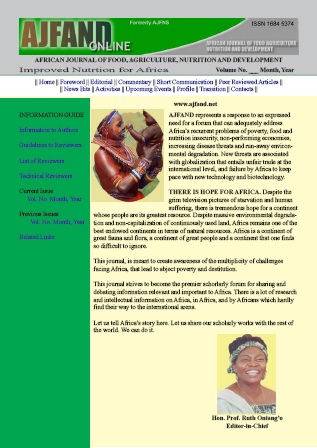
|
African Journal of Food, Agriculture, Nutrition and Development
Rural Outreach Program
ISSN: 1684-5358
EISSN: 1684-5358
Vol. 19, No. 1, 2019, pp. 14354-14371
|
 Bioline Code: nd19020
Bioline Code: nd19020
Full paper language: French
Document type: Research Article
Document available free of charge
|
|
|
African Journal of Food, Agriculture, Nutrition and Development, Vol. 19, No. 1, 2019, pp. 14354-14371
| en |
Pousga, S; Sankara, F; Coulibaly, K; Nacoulma, JP; Ouedraogo, S; Kenis, M; Chrysostome, C & Ouedraogo, GA
Abstract
The high cost and the accessibility of animal protein sources is a major issue in poultry
farming in Burkina Faso. The present study aimed to assess the suitability of two termite
species as feed for traditional chicken ( Gallus domesticus

) and guinea fowl ( Numida meleagris

), comparatively to commercial fishmeal available in this country. The study
was carried out during eight weeks in Burkina Faso on ninety chickens and ninety guinea
fowls, sixteen weeks old. Two termite species (dry Macrotermes subhyalinus

and fresh
Macrotermes bellicosus

) and commercial fishmeal for poultry feed formulation that is
available in the country were used as animal protein ingredients in three feeding
management regimes. The birds were allocated to the three feeding treatments, with two
replicates per treatment: i) treatment 1 (R1) with a diet including 2.5% of dried termites;
ii) treatment 2 (R2) diet with no animal protein ingredient included, but with fresh
termites given separately and the amount was depending on the daily capture; iii)
treatment 3 (R3) diet including 2.5% of fishmeal. The results showed an average daily
feed consumption of 65.5 g per bird. Average daily gain (ADG) for chickens was 7.7 g,
7.8 g and 7.5 g for treatment R1, R2 and R3, respectively. ADG for guinea fowl was 5.64
g, 5.34 g and 5.35 g for R1, R2 and R3, respectively. Carcass characteristics studied on
male guinea fowl showed a mean carcass percentage of 66.4%. Data on the taste and
tenderness showed that R1 and R2 gave a better taste to guinea fowl meat, while R3 and
R2 gave more tender meat. Average dry matter contents of the thighs were 42.4%, 41.8%
and 40.6% for the groups R1, R2 and R3, respectively. No significant difference (p>0.05)
was observed between treatments for all the parameters. Thus, dry and fresh
Macrotermes spp. can be suitable animal protein ingredients that can substitute fishmeal
in traditional chickens and guinea fowl feeding in rural area.
termites; fishmeal; feeding; local poultry; live weight performances; Burkina Faso
|
| |
| fr |
EFFETS DU REMPLACEMENT DE LA FARINE DE POISSON PAR LES TERMITES ( MACROTERMES  SP.) SUR L’EVOLUTION PONDERALE ET LES CARACTERISTIQUES DE CARCASSE DE LA VOLAILLE LOCALE AU BURKINA FASO SP.) SUR L’EVOLUTION PONDERALE ET LES CARACTERISTIQUES DE CARCASSE DE LA VOLAILLE LOCALE AU BURKINA FASO
Pousga, S; Sankara, F; Coulibaly, K; Nacoulma, JP; Ouedraogo, S; Kenis, M; Chrysostome, C & Ouedraogo, GA
Résumé
Une étude a été conduite durant huit semaines sur des poulets et des pintades âgés de
seize semaines. L’objectif était d’apporter des solutions aux problèmes des protéines
animales en nutrition aviaire à travers l’évaluation de deux espèces de termites dans
l’alimentation des poulets ( Gallus domesticus

) et des pintades ( Numida meleagris

). La
farine de poisson commerciale et les deux espèces de termites ( Macrotermes subhyalinus

séché et M. bellicosus

frais) ont été utilisées dans les trois rations alimentaires suivantes :
ration 1 (R1) contenant 2,5% de termites séchés ; ration 2 (R2) distribuée avec des
termites frais dont la quantité dépendait de la capture journalière ; ration 3 (R3) contenant
2,5% de farine de poisson. Les oiseaux ont été répartis en trois lots représentant trois
rations alimentaires. Les résultats ont montré une consommation alimentaire moyenne
générale de 65,5 g par individu. Au niveau des poulets, les gains moyens quotidiens
(GMQ) étaient de 7,7 g pour le groupe R1, 7,8 g pour R2 et 7,5 g pour R3. Pour les
pintades, ces résultats étaient de 5,6 g, 5,3 g et 5,3 g respectivement, pour R1, R2 et R3.
Le rendement moyen en carcasse chez les pintades mâles a été de 66,4%. Le goût de la
viande des pintades nourries avec R1 et R2 a été meilleur à celui de la viande des pintades
nourries avec les rations R3. Par contre les viandes des pintades nourries avec les rations
R3 et R2 ont été plus tendres que celle des pintades nourries avec R1. La teneur moyenne
en matière sèche des cuisses était de 42,4%, 41,8% et 40,6 %, respectivement pour les
groupes R1, R2 et R3. Aucune différence significative (p>0,05) n’a existé entre les
rations pour ces différents paramètres. En somme les Macrotermes spp. frais ou séchés
peuvent être des sources de protéines animales substituables à la farine de poisson en
aviculture traditionnelle.
termites; farine de poisson; alimentation; volaille locale performances pondérales; Burkina Faso
|
| |
© Copyright 2019 - African Journal of Food, Agriculture, Nutrition and Development
Alternative site location: http://www.ajfand.net/
|
|
